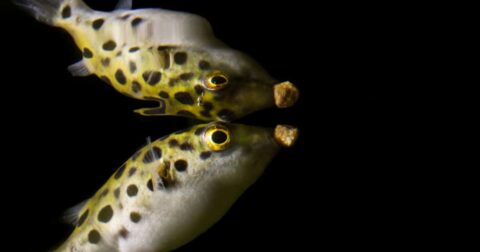News
Bird Flu Virus Might Resist Fever, Study in Mice Finds
Research•5 min read
Analysis
A new study finds fish can recognize their own reflection and distinguish themselves from other fish.


Words by Devatha P. Nair
A two-year-old toddler flashes her toothy grin as she catches sight of her reflection in a mirror and watches as the image in front of her mimics her every move. Unbeknownst to her, she has passed a major developmental milestone called mirror self-recognition or MSR, which indicates an advanced level of cognitive capabilities in both human and non-human animals.
A new study shows that in addition to other non-human animals like dolphins, elephants and several great apes, fish can recognize themselves in mirror reflections and photographs. What’s more, they can even distinguish between photographs of their own images and that of their companions. Researchers studying the cleaner fish (Labroides dimidiatus) have now added their findings to a growing body of evidence that points to fish having a sense of self, indicating a higher depth of awareness than previously known.
Mirror self-recognition has been used to study self-awareness and visual recognition in a wide range of human and non-human animals. Developed for primates in the 1970s, the test begins by allowing the individual to familiarize herself with her mirror image.
Researchers then anesthetize the animal and place a mark on a part of the body that the animal cannot typically see without the help of a mirror. When the animal recovers from the effects of the anesthetic, she is allowed to view her image in a mirror. If she attempts to inspect or remove the foreign mark from her body, those actions signify self-recognition.
In this study, once the fish were allowed to familiarize themselves with their reflections, they were anesthetized, then a brown mark was placed on their throats. After they woke up and were presented with their reflections, 17 out of the 18 fish responded by trying to remove the spot by attempting to rub it off. By contrast, none of the unmarked fish in the control group displayed similar behavior.
After the MSR tests, the fish were shown photographs of themselves in which a mark was placed on their throats by drawing on the image. In this experiment, 75 percent of fish responded by trying to rub their throats to get rid of the mark — indicating that fish can recognize themselves even in static images.
What’s more, when the fish were shown photographs of their companion fish with similar marks drawn on their throats, they did not attempt to rub the mark away. In other words, they were able to differentiate between their own photographs and that of companion fish.
The ability to recognize oneself in a photograph indicates that the fish had developed a mental image of what they look like, and could rely on this image for self-recognition. These abilities require a higher level of cognition and mental state.
Previous studies have shown that fish can both identify individual human faces and distinguish between familiar human faces based on facial characteristics. In this study, the fish were shown four different photographs that consisted of photographs of 1) themselves, 2) their face on an unfamiliar fish’s body, 3) an unfamiliar fish’s face morphed onto their body, and 4) an unfamiliar fish. The fish responded by displaying aggressive behavior toward photographs that did not contain their faces but did not attack the photographs that had images of their own face on it.
In humans, the ability to rapidly recognize faces in photographs and mirror reflections come by comparing the image in front of us to a mental image we have of the person. To tell the difference between familiar and unfamiliar individuals, the fish too would have to retain mental images of other faces in order to rapidly identify the photograph shown to them.
According to the authors, this ability to recall faces and then modulate their response to be friendly or to be aggressive suggests that cleaner fish have the capacity for private self-awareness and mental states associated with mental images of what they look like, and are motivated to behave accordingly.
This latest study adds to a growing body of research that shows that fish have the ability to recognize themselves and differentiate themselves from others. While these mirror tests are often criticized for relying on a narrow definition of self-awareness, the ability of a small, 10 cm cleaner fish to recognize itself and others points to advanced levels of cognition — including the ability to suffer and feel pain.
This body of research upends the common assumption that fish are less intelligent or incapable of suffering. Fish experience fear, pain and terror when they are killed, yet there are no welfare regulations in the U.S. requiring the humane treatment of fish.
As part of a $150 billion commercial global industry that produces more than 185 million tons of these creatures each year, fish can be killed by chilling the water to freezing temperatures, severing their gill arches, piercing their hearts, suffocation or by exposure to carbon monoxide. Perhaps this new research will help pave a path forward.